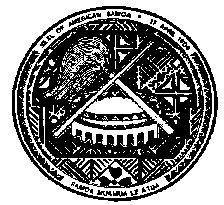|
The People of Samoa
by Samoa Koria, San Diego, California
OUR PEOPLE: The Samoan Islands are part of Polynesia, and lie in the South Pacific about 2,400 miles southwest of Hawai'i. Historically, the British, German, and American governments all vied for political domination of the Islands. Today, the Islands are divided into two regions:
OUR RELIGION: There has always been some worshiping to God. This means that you'll find Samoans into many different kinds of churches from Buddhism to Christianity. Also, our clergy nine times out of ten, come from the theological schools based on the Islands. OUR COMMUNITY: We are divided into villages - each with a representative called the "matai" (chief of the family) who directs and facilitates all family business inside the village and out. OUR FOODS: The coconut is an everyday part of our diet. The use of bananas and the taro root is our main staple. Pork, chicken, beef, and fish provide other parts of a daily meal. OUR WAY OF LIFE: The Samoan "way of life" called Fa'a Samoa is based on respecting our elders and ensuring the well-being of our immediate family at any cost. This fundamental premise is what keeps our culture and language alive today to instill a sense of self-esteem and self pride. OUR AGRICULTURE: With year-round tropical weather that exhibits wind, rain, and sunshine within an hour of the day, the land is very fertile to grow just about anything that will help for meal preparations for the day. OUR MUSIC: Much of our music reflects growing trends of the time and always tells stories of how we live life in Samoa. Main genres produced and performed are religious. familial, country humor and "islandish" music.  OUR GOVERNMENT: In American Samoa, the political process is very similar to the election of state officials (governor, senators, etc.). However, Western Samoa is also very similar with the election of state officials (governor and legislatures) and we've adopted parliamentary procedures as the form of government. OUR CITIZENSHIP: All who are born in American Samoa are United States nationals and are free to travel to the United States. All who are born in Western Samoa are considered "foreigners" and must therefore obtain visas to enter the United States. OUR CULTURAL SYMBOL: Our official seal shown above bears the cultural symbols of our Samoan culture -- the Fue, the To'oto'o, and the Kava Bowl. The Fue represents wisdom, the To'oto'o (staff) represents authority. Together, these are used by the chiefs of the land and indicate their elevated ranking. The Kava Bowl symbolizes service to the chiefs. This bowl is traditionally used during the Kava Ceremony, one of the highest and most formal rituals of the Samoan culture. The 'Ava. |
||||||||||||||||||||||
| Published in In Motion Magazine - December 10, 1995. |
||||||||||||||||||||||
If you have any thoughts on this or would like to contribute to an ongoing discussion in the  What is New? || Affirmative Action || Art Changes || Autonomy: Chiapas - California || Community Images || Education Rights || E-mail, Opinions and Discussion || En español || Essays from Ireland || Global Eyes || Healthcare || Human Rights/Civil Rights || Piri Thomas || Photo of the Week || QA: Interviews || Region || Rural America || Search || Donate || To be notified of new articles || Survey || In Motion Magazine's Store || In Motion Magazine Staff || In Unity Book of Photos || Links Around The World NPC Productions Copyright © 1995-2020 NPC Productions as a compilation. All Rights Reserved. |
||||||||||||||||||||||


 In 1995, the Pacific Islander community of San Diego held its first major community festival - more than 60,000 people came to the two-day festival, July 22nd and 23rd.
In 1995, the Pacific Islander community of San Diego held its first major community festival - more than 60,000 people came to the two-day festival, July 22nd and 23rd.
